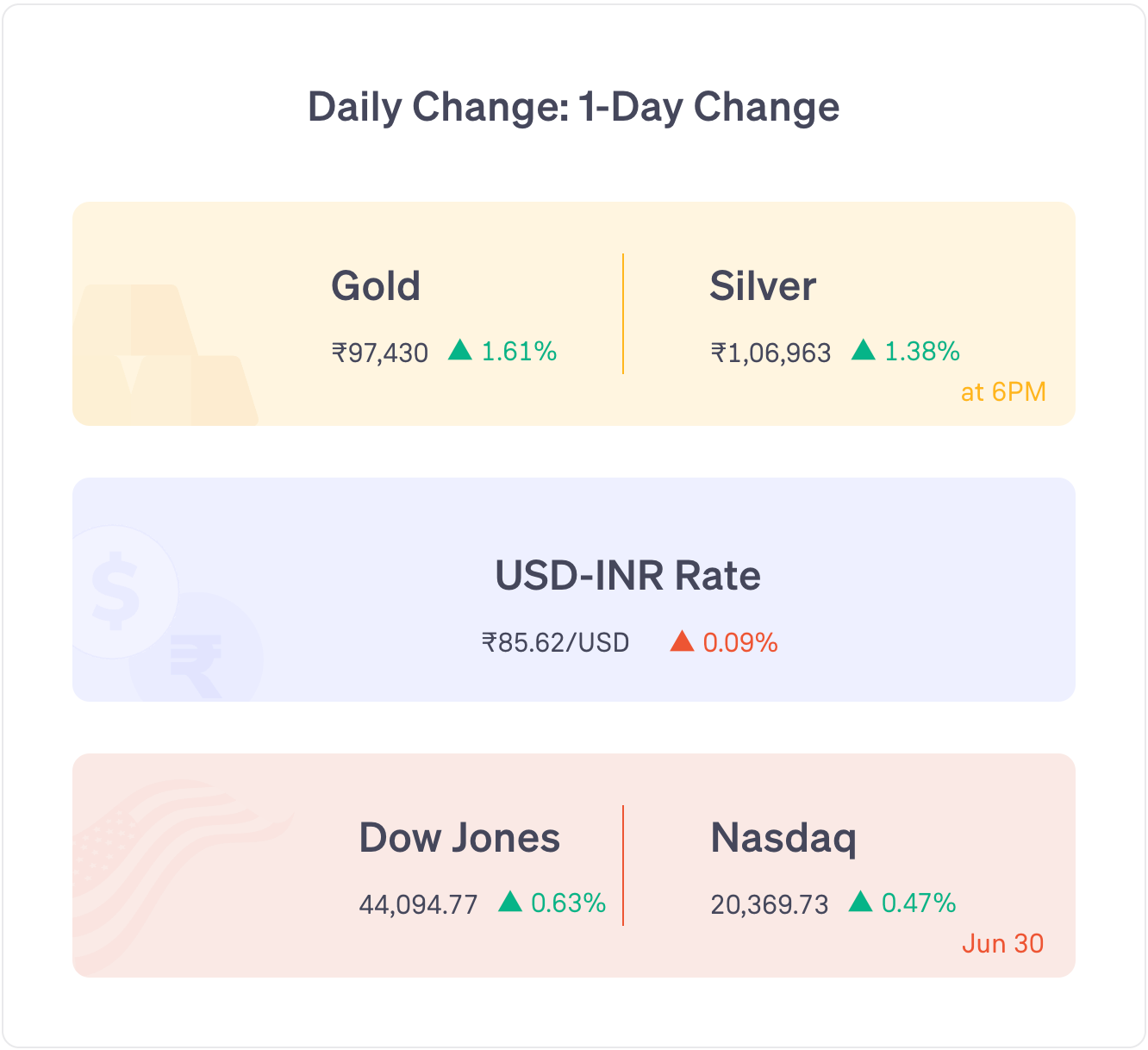Manufacturing rises in June, Apollo Hospitals to demerge pharmacy business, & more
Tuesday, 1 July 2025
Markets opened slightly above yesterday’s closing point.
Nifty 50 made sharp swings in the early hours. It then stayed in a range and closed positively.
PSU bank stocks and oil and gas stocks rose the most today. Media stocks and FMCG stocks fell the most.
Global markets: US markets rose and European markets fell. Asian markets showed a mixed trend.
News
India’s manufacturing PMI rose to 58.4 in June (vs 57.6 in May). This means manufacturing grew more in June than in May.
Government has approved Research Development and Innovation (RDI) Scheme to financially support R&D in the private sector. Government has allocated Rs 1 lakh crore for it.
India’s gross GST collection grew 6.2% year-on-year to Rs 1.85 lakh crore in June (vs Rs 2.01 lakh crore in May).
Government has approved the Employment Linked Incentive (ELI) scheme aiming to generate 3.5 crore jobs in 2 years. The government has allocated Rs 99,446 crore for its implementation.
Tenneco Green Air India has filed a Draft Red Herring Prospectus (DRHP) with SEBI for a Rs 3,000 crore IPO.
Hero Motors has refiled its DRHP with SEBI and increased the issue size from Rs 900 crore to Rs 1,200 crore.
Shadowfax Technologies has filed a DRHP with SEBI through the confidential route.
Stocks Updates
Apollo Hospitals: will demerge its pharmacy and digital health businesses into a new listed company, and aims to merge it with Apollo HealthCo and Keimed. Shareholders of the company will receive 195.2 shares of the newly formed company, for every 100 shares held in Apollo Hospitals.
Lupin: separated its consumer healthcare division, LupinLife, into a wholly-owned subsidiary to solely focus on the over-the-counter healthcare market, effective from 1 July 2025. It also received US FDA approval for its generic Loteprednol Etabonate Ophthalmic Gel used for treating post-surgical eye inflammation and pain. It had an estimated annual sales of $29 million in the US.
Coal India: signed a non-binding Memorandum of Understanding (MoU) with Hindustan Copper to jointly work in copper and critical minerals sectors.
Adani Enterprises: will launch a public issue of secured non-convertible debentures worth up to Rs 1,000 crore, with tenures ranging from 24 to 60 months and coupon rates up to 9.3%.
JSW Energy: a company subsidiary signed a 12-year agreement with RVUNL to develop a 250 MW / 500 MWh battery energy storage system in Rajasthan.
Bharat Electronics: received orders worth Rs 528 crore for radars, communication equipment, EVMs, jammers, etc.
CG Power: launched a Qualified Institutional Placement (QIP) issue to raise up to Rs 3,000 crore.
L&T: company subsidiary, L&T Energy Green Tech, incorporated a new step-down subsidiary, Panipat Green Hydrogen Pvt Ltd, to develop green hydrogen projects.
Word of the Day
Call Option
It is a contract which gives a buyer the right to buy an asset at a fixed price within a certain period of time
This asset can be a stock, bond, commodity, etc.
It is a right, not an obligation. The buyer can choose not to use it.
The buyer has to pay a premium for this right.
Call options are used when an investor expects the asset’s price to rise.
Let's say the price rises above the set price (called the strike price).
The buyer can now buy the asset at a lower price (as per the call option) — and sell it at the market price. The difference between the strike price and the market price is the profit.
Example: You buy a call option on a stock at a strike price of Rs 500.
If the market price rises to Rs 550, you can buy the stock at Rs 500 and sell at Rs 550.
Thus, your profit = Rs 50 — premium paid.
Call options are mostly used in derivative trading.
6 Day Course
Theme: FIRE
Day 2: Tuesday
With FIRE, the rate of withdrawal matters a lot.
A withdrawal rate of 4% per annum would mean your money would last about 30 years.
If you reduce the 4% number, it’ll last longer. At one point, the withdrawal rate will be much lower than the growth rate. Which means, the money will always be growing and never falling — you will never run out of money.
Example: let’s say your stocks + bonds or mutual fund portfolio is able to give about 10% per annum. Let’s take inflation at 5% per annum.
So, your real returns are 5% per annum (after removing inflation).
Now, if you withdraw 2% per annum, you will practically never run out of money. Because even after you remove 2%, you are still left with 3% real returns per year.
Why not a withdrawal rate of 4%?
If you withdraw 4% per annum, your real return = 1% per annum.
If your returns dip in a certain year and/or inflation rises, you will make no real returns or make negative returns that year.
Thus, a lower withdrawal rate provides better margin of safety.
Featured Question
Q. “Retail investors pay short-term or long-term capital gains tax based on how long they hold their shares. In the case of mutual funds, when the fund manager sells shares from the portfolio, is any tax applicable? If so, who bears the tax burden?”
When a mutual fund buys or sells, there is no tax that investors need to worry about.
The only tax applied (short term or long term) is if an investor decides to withdraw money from the mutual fund.
There is no tax on the changes a mutual fund makes to its holdings and assets.
The absence of these taxes makes it easier for mutual funds to generate slightly higher returns.
Did you like this edition?
Leave a feedback here!






